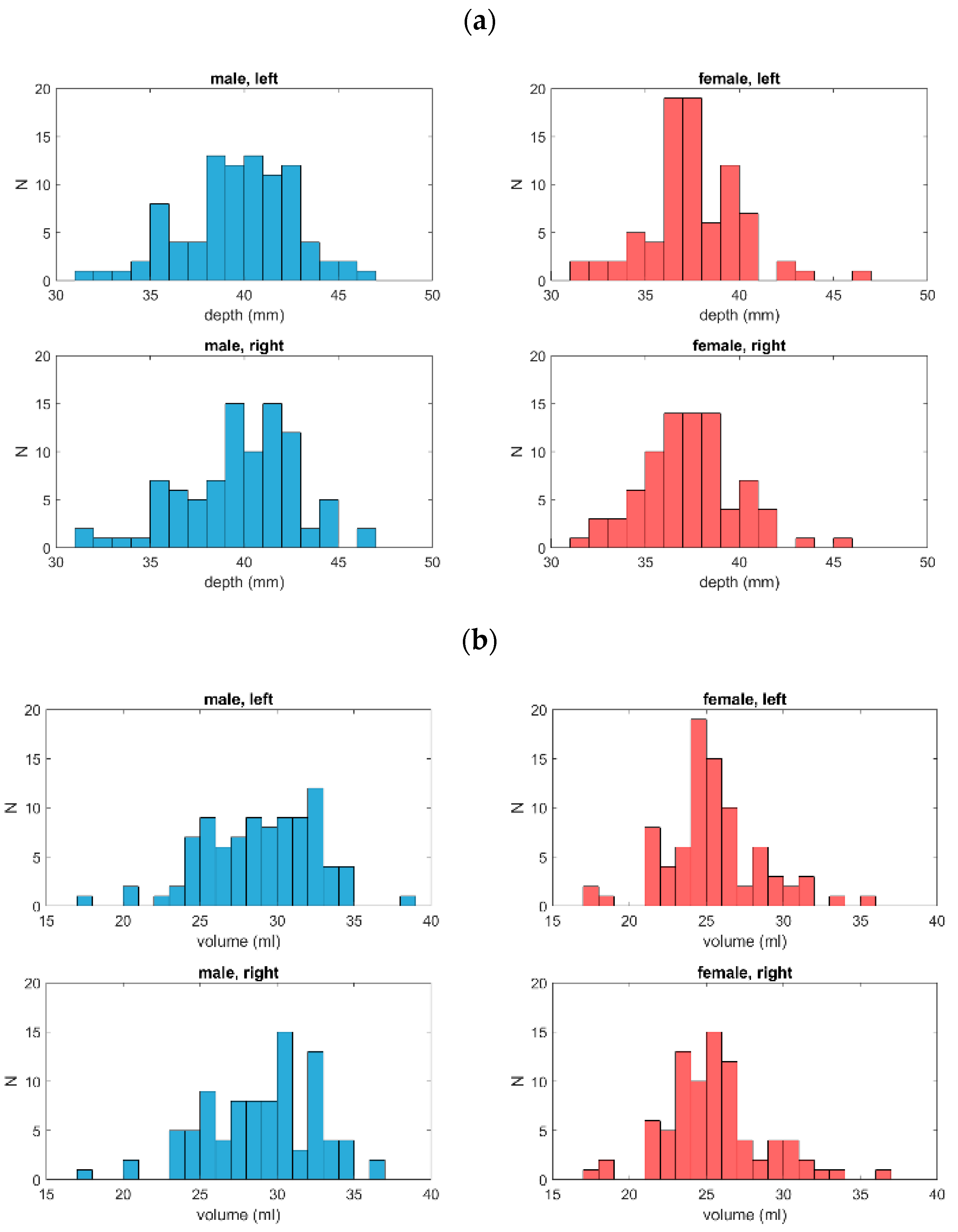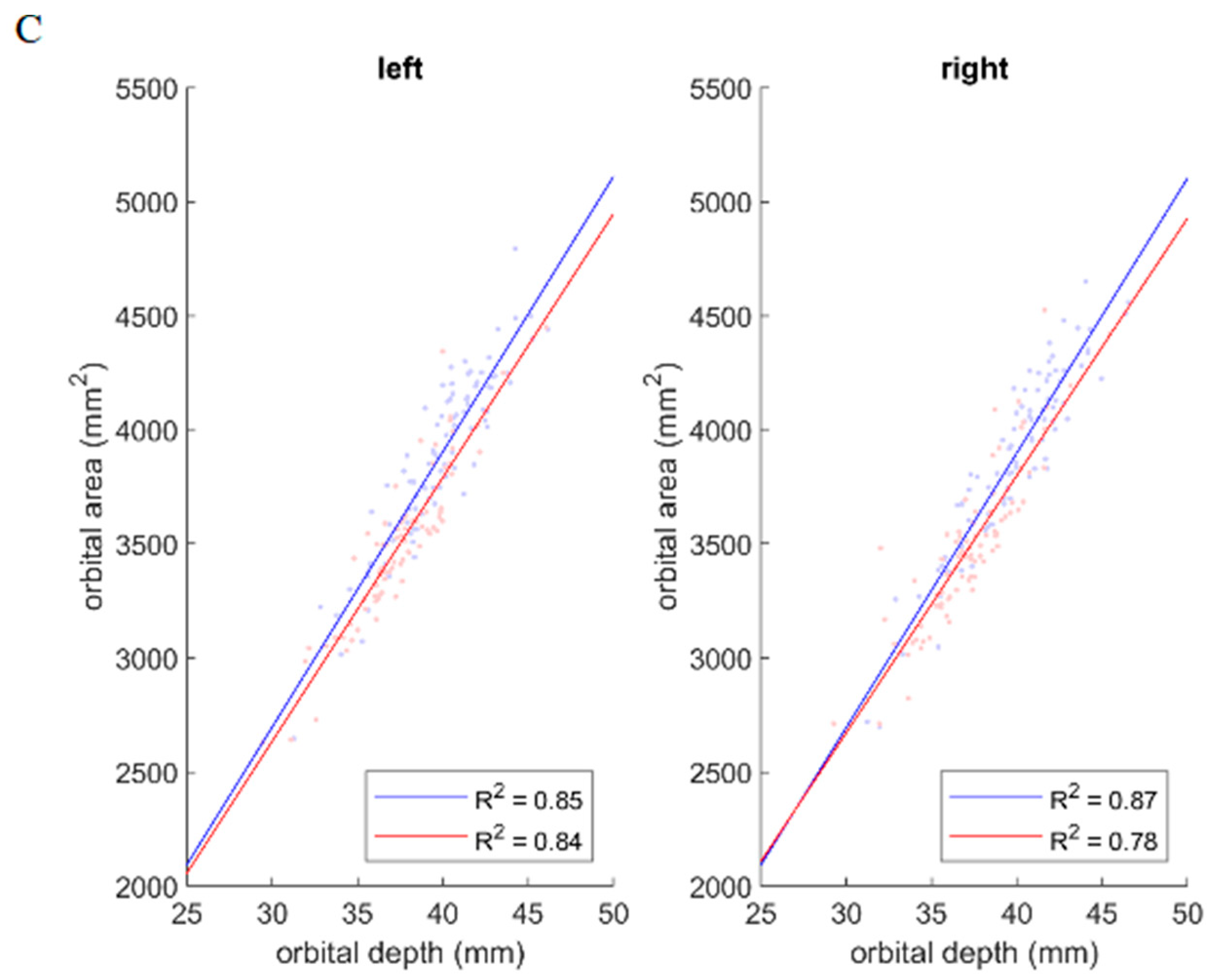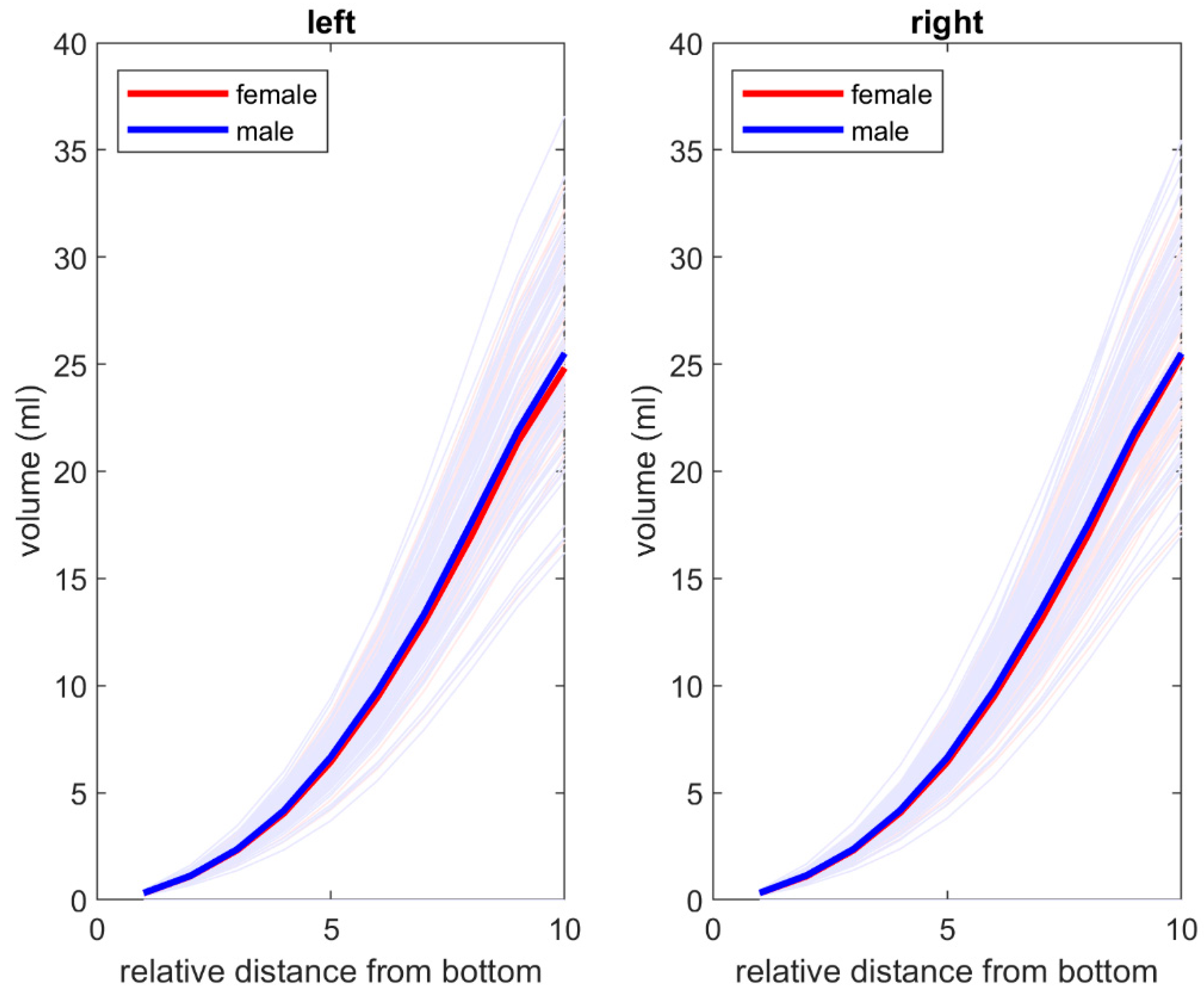Automated 3-D Computer-Aided Measurement of the Bony Orbit: Evaluation of Correlations among Volume, Depth, and Surface Area
Abstract
1. Introduction
2. Materials and Methods
- (1)
- Volumes of left- and right-side orbits (meshes): The volumes of the left- and right-side meshes were calculated as the sum of the volumes of the tetrahedral elements that resulted from the segmentation algorithm;
- (2)
- Surface areas of left- and right-side orbits (meshes): The surface areas of the left- and right-side meshes were calculated as the sum of the areas of the surface elements of the orbit;
- (3)
- Depth measurement of the orbit: This measurement is visualized in Figure 2.
3. Results
4. Discussion
5. Conclusions
Author Contributions
Funding
Institutional Review Board Statement
Informed Consent Statement
Data Availability Statement
Conflicts of Interest
References
- Choi, S.H.; Kang, D.H.; Gu, J.H. The Correlation between the Orbital Volume Ratio and Enophthalmos in Unoperated Blowout Fractures. Arch. Plast. Surg. 2016, 43, 518–522. [Google Scholar] [CrossRef] [PubMed]
- Essig, H.; Dressel, L.; Rana, M.; Rana, M.; Kokemueller, H.; Ruecker, M.; Gellrich, N.C. Precision of posttraumatic primary orbital reconstruction using individually bent titanium mesh with and without navigation: A retrospective study. Head Face Med. 2013, 9, 18. [Google Scholar] [CrossRef] [PubMed]
- Nilsson, J.; Nysjö, J.; Carlsson, A.P.; Thor, A. Comparison analysis of orbital shape and volume in unilateral fractured orbits. J. Craniomaxillofac. Surg. 2018, 46, 381–387. [Google Scholar] [CrossRef] [PubMed]
- Raskin, E.M.; Millman, A.L.; Lubkin, V.; della Rocca, R.C.; Lisman, R.D.; Maher, E.A. Prediction of late enophthalmos by volumetric analysis of orbital fractures. Ophthalmic. Plast. Reconstr. Surg. 1998, 14, 19–26. [Google Scholar] [CrossRef] [PubMed]
- Schuknecht, B.; Carls, F.; Valavanis, A.; Sailer, H.F. CT assessment of orbital volume in late post-traumatic enophthalmos. Neuroradiology 1996, 38, 470–475. [Google Scholar] [CrossRef]
- Goldberg, R.A.; Hannani, K.; Toga, A.W. Microanatomy of the orbital apex. Computed tomography and microcryoplaning of soft and hard tissue. Ophthalmology 1992, 99, 1447–1452. [Google Scholar] [CrossRef] [PubMed]
- Kunz, C.; Sigron, G.R.; Jaquiéry, C. Functional outcome after non-surgical management of orbital fractures--the bias of decision-making according to size of defect: Critical review of 48 patients. Br. J. Oral. Maxillofac. Surg. 2013, 51, 486–492. [Google Scholar] [CrossRef]
- Ploder, O.; Klug, C.; Voracek, M.; Backfrieder, W.; Tschabitscher, M.; Czerny, C.; Baumann, A. A computer-based method for calculation of orbital floor fractures from coronal computed tomography scans. J. Oral. Maxillofac. Surg. 2001, 59, 1437–1442. [Google Scholar] [CrossRef] [PubMed]
- Stathopoulos, P.; Ameerally, P. Reconstructing a Traumatic Empty Orbit: Principles, Difficulties of Treatment, and Literature Review. J. Oral. Maxillofac. Surg. 2018, 76, 1952.e1–1952.e4. [Google Scholar] [CrossRef]
- Ozdikici, M.; Bulut, E.; Agca, S. Assessment of the orbital structures using computed tomography in healthy adults. Niger. J. Clin. Pract. 2021, 24, 561–568. [Google Scholar] [CrossRef]
- Felding, U.A.; Bloch, S.L.; Buchwald, C.V. The Dimensions of the Orbital Cavity Based on High-Resolution Computed Tomography of Human Cadavers. J. Craniofac Surg. 2016, 27, 1090–1093. [Google Scholar]
- Forbes, G.; Gehring, D.G.; Gorman, C.A.; Brennan, M.D.; Jackson, I.T. Volume measurements of normal orbital structures by computed tomographic analysis. AJR Am. J. Roentgenol. 1985, 145, 149–154. [Google Scholar] [CrossRef] [PubMed]
- Deveci, M.; Oztürk, S.; Sengezer, M.; Pabuşcu, Y. Measurement of orbital volume by a 3-dimensional software program: An experimental study. J Oral Maxillofac Surg. 2000, 58, 645–648. [Google Scholar] [CrossRef]
- Chepurnyi, Y.; Chernohorskyi, D.; Prykhodko, D.; Poutala, A.; Kopchak, A. Reliability of orbital volume measurements based on computed tomography segmentation: Validation of different algorithms in orbital trauma patients. J. Craniomaxillofac. Surg. 2020, 48, 574–581. [Google Scholar] [CrossRef] [PubMed]
- Wagner, M.E.; Gellrich, N.C.; Friese, K.I.; Becker, M.; Wolter, F.E.; Lichtenstein, J.T.; Stoetzer, M.; Rana, M.; Essig, M. Model-based segmentation in orbital volume measurement with cone beam computed tomography and evaluation against current concepts. Int. J. Comput. Assist. Radiol. Surg. 2016, 11, 1–9. [Google Scholar] [CrossRef] [PubMed]
- Diaconu, S.C.; Dreizin, D.; Uluer, M.; Mossop, C.; Grant, M.P.; Nam, A.J. The validity and reliability of computed tomography orbital volume measurements. J. Craniomaxillofac. Surg. 2017, 45, 1552–1557. [Google Scholar] [CrossRef] [PubMed]
- Wagner, M.E.; Lichtenstein, J.T.; Winkelmann, M.; Shin, H.O.; Gellrich, N.C.; Essig, H. Development and first clinical application of automated virtual reconstruction of unilateral midface defects. J. Craniomaxillofac. Surg. 2015, 43, 1340–1347. [Google Scholar] [CrossRef] [PubMed]
- Osaki, T.H.; de Castro, D.K.; Yabumoto, C.; Mingkwansook, V.; Ting, E.; Nallasamy, N.; Curtin, H.; Fay, A.M.D. Comparison of methodologies in volumetric orbitometry. Ophthalmic. Plast. Reconstr. Surg. 2013, 29, 431–436. [Google Scholar] [CrossRef] [PubMed]
- Jansen, J.; Schreurs, R.; Dubois, L.; Maal, T.J.; Gooris, P.J.; Becking, A.G. Orbital volume analysis: Validation of a semi-automatic software segmentation method. Int. J. Comput. Assist. Radiol. Surg. 2016, 11, 11–18. [Google Scholar] [CrossRef]
- Chepurnyi, Y.; Zhukovtseva, O.; Kopchak, A.; Kanura, O. Clinical application of automated virtual orbital reconstruction for orbital fracture management with patient-specific implants: A prospective comparative study. J. Craniomaxillofac. Surg. 2022, 50, 686–691. [Google Scholar] [CrossRef]
- Tandon, R.; Aljadeff, L.; Ji, S.; Finn, R.A. Anatomic Variability of the Human Orbit. J. Oral. Maxillofac. Surg. 2020, 78, 782–796. [Google Scholar] [CrossRef] [PubMed]
- Kang, H.S.; Han, J.J.; Oh, H.K.; Kook, M.S.; Jung, S.; Park, H.J. Anatomical Studies of the Orbital Cavity Using Three-Dimensional Computed Tomography. J. Craniofac. Surg. 2016, 27, 1583–1588. [Google Scholar] [CrossRef] [PubMed]
- Wilkat, M.; Hufendiek, K.; Karahisarlioglu, M.; Borrelli, M.; Sproll, C.; Rana, M. Prospective Evaluation of Two Wall Orbital Fractures Involving the Medial Orbital Wall: PSI Reconstruction versus PDS Repair-Worth the Effort? J. Pers. Med. 2022, 12, 1389. [Google Scholar] [CrossRef] [PubMed]
- Fu, Y.; Liu, S.; Li, H.; Yang, D. Automatic and hierarchical segmentation of the human skeleton in CT images. Phys. Med. Biol. 2017, 62, 2812–2833. [Google Scholar] [CrossRef] [PubMed]
- Salmi, M.; Paloheimo, K.S.; Tuomi, J.; Wolff, J.; Mäkitie, A. Accuracy of medical models made by additive manufacturing (rapid manufacturing). J. Craniomaxillofac. Surg. 2013, 41, 603–609. [Google Scholar] [CrossRef] [PubMed]
- Jansen, J.; Dubois, L.; Schreurs, R.; Gooris, P.J.; Maal, T.J.; Beenen, L.F.; Becking, A.G. Should Virtual Mirroring Be Used in the Preoperative Planning of an Orbital Reconstruction? J Oral Maxillofac Surg. 2018, 76, 380–387. [Google Scholar] [CrossRef] [PubMed]
- Lieger, O.; Schaub, M.; Taghizadeh, E.; Büchler, P. How Symmetrical Are Bony Orbits in Humans? J. Oral. Maxillofac. Surg. 2019, 77, 118–125. [Google Scholar] [CrossRef] [PubMed]
- Ching, J.A.; Ford, J.M.; Decker, S.J. Aging of the Adult Bony Orbit. J Craniofac Surg. 2020, 31, 1082–1085. [Google Scholar] [CrossRef] [PubMed]
- Metzger, M.C.; Schön, R.; Tetzlaf, R.; Weyer, N.; Rafii, A.; Gellrich, N.C.; Schmelzeisen, R. Topographical CT-data analysis of the human orbital floor. Int. J. Oral. Maxillofac. Surg. 2007, 36, 45–53. [Google Scholar] [CrossRef]
- Schönegg, D.; Wagner, M.; Schumann, P.; Essig, H.; Seifert, B.; Rücker, M.; Gander, T. Correlation between increased orbital volume and enophthalmos and diplopia in patients with fractures of the orbital floor or the medial orbital wall. J. Craniomaxillofac. Surg. 2018, 46, 1544–1549. [Google Scholar] [CrossRef]








| Left | Right | ||
|---|---|---|---|
| Male | Volume | 0.0665 | 0.2865 |
| Depth | 0.3821 | 0.0933 | |
| Area | 0.0769 | 0.0362 | |
| Female | volume | 0.0231 | 0.0142 |
| Depth | 0.036 | 0.2524 | |
| Area | 0.0471 | 0.0234 |
| Mean | Median | Std | Min | Max | |||||||
|---|---|---|---|---|---|---|---|---|---|---|---|
| Left | Right | Left | Right | Left | Right | Left | Right | Left | Right | ||
| Depth (mm) | Male | 39.74 | 39.83 | 40.00 | 40.29 | 2.91 | 3.07 | 31.27 | 31.24 | 46.15 | 46.53 |
| Female | 37.41 | 37.27 | 37.33 | 37.30 | 2.67 | 2.65 | 29.45 | 29.26 | 46.06 | 45.44 | |
| Volume (mL) | Male | 28.95 | 29.02 | 29.61 | 29.40 | 3.63 | 3.63 | 17.37 | 17.91 | 38.43 | 36.85 |
| Female | 25.39 | 25.48 | 25.13 | 25.19 | 3.14 | 3.25 | 17.36 | 17.90 | 35.29 | 36.78 | |
| Area (mm2) | Male | 3878.68 | 3871.49 | 3952.46 | 3898.07 | 395.61 | 382.11 | 2697.10 | 2646.76 | 4648.56 | 4793.88 |
| Female | 3492.22 | 3490.72 | 3465.58 | 3494.79 | 339.04 | 336.55 | 2712.26 | 2628.22 | 4523.00 | 4448.10 | |
| Male vs. Female | Left vs. Right | Larger vs. Smaller | ||||
|---|---|---|---|---|---|---|
| Left | Right | Male | Female | Male | Female | |
| Volume | 1.00 × 10−10 | 2.00 × 10−10 | 0.90 (0.39) | 0.87 (0.25) | 0.30 (9.08 × 10−17) | 0.29 (4.75 × 1019) |
| Depth | 4.78 × 10−8 | 2.34 × 10−8 | 0.83 (0.29) | 0.74 (0.09) | 0.17 (5.47 × 10−15) | 0.17 (3.11 × 10−19) |
| Area | 7.36 × 10−11 | 1.03 × 10−10 | 0.90 (0.47) | 0.98 (0.90) | 0.23 (4.04 × 10−16) | 0.18 (3.50 × 10−11) |
| Men | Women | |||
|---|---|---|---|---|
| Left | Right | Left | Right | |
| V × L | 0.71 | 0.73 | 0.58 | 0.51 |
| A × L | 0.85 | 0.87 | 0.84 | 0.78 |
| A × V | 0.96 | 0.95 | 0.87 | 0.87 |
| Left Orbit | Right Orbit | |
|---|---|---|
| Gender | 0.28 | 0.36 |
| Depth | 7.5 × 10−21 | 3.8 × 10−19 |
| Gender:Depth | 0.17 | 0.24 |
| Case | Left | Right | |
|---|---|---|---|
| Volume (mL) | Volume (mL) | ICCInter | |
| 1 | 26.2385062253374 | 26.2451287432629 | 1.0 |
| 2 | 21.9440769622081 | 22.0701658712400 | 1.0 |
| 3 | 24.0008755588866 | 23.1272418086540 | 1.0 |
| 4 | 27.2269541561696 | 27.7177708636990 | 1.0 |
| 5 | 24.5145413957817 | 24.4206587669105 | 1.0 |
| 6 | 32.0841617415446 | 30.3179772618623 | 1.0 |
| 7 | 22.1295163397493 | 22.2934083714752 | 1.0 |
| 8 | 28.3998038601918 | 28.6345913023606 | 1.0 |
| 9 | 24.5112274735212 | 24.7703571039611 | 1.0 |
| 10 | 25.5450934482375 | 25.4178357770615 | 1.0 |
| ICCintra | 1.0 | 1.0 | Excellent |
Disclaimer/Publisher’s Note: The statements, opinions and data contained in all publications are solely those of the individual author(s) and contributor(s) and not of MDPI and/or the editor(s). MDPI and/or the editor(s) disclaim responsibility for any injury to people or property resulting from any ideas, methods, instructions or products referred to in the content. |
© 2024 by the authors. Licensee MDPI, Basel, Switzerland. This article is an open access article distributed under the terms and conditions of the Creative Commons Attribution (CC BY) license (https://creativecommons.org/licenses/by/4.0/).
Share and Cite
Kontio, R.; Wilkman, T.; Mesimäki, K.; Chepurnyi, Y.; Asikainen, A.; Haapanen, A.; Poutala, A.; Mikkonen, M.; Slobodianiuk, A.; Kopchak, A. Automated 3-D Computer-Aided Measurement of the Bony Orbit: Evaluation of Correlations among Volume, Depth, and Surface Area. J. Pers. Med. 2024, 14, 508. https://doi.org/10.3390/jpm14050508
Kontio R, Wilkman T, Mesimäki K, Chepurnyi Y, Asikainen A, Haapanen A, Poutala A, Mikkonen M, Slobodianiuk A, Kopchak A. Automated 3-D Computer-Aided Measurement of the Bony Orbit: Evaluation of Correlations among Volume, Depth, and Surface Area. Journal of Personalized Medicine. 2024; 14(5):508. https://doi.org/10.3390/jpm14050508
Chicago/Turabian StyleKontio, Risto, Tommy Wilkman, Karri Mesimäki, Yurii Chepurnyi, Antti Asikainen, Aleksi Haapanen, Arto Poutala, Marko Mikkonen, Alina Slobodianiuk, and Andrii Kopchak. 2024. "Automated 3-D Computer-Aided Measurement of the Bony Orbit: Evaluation of Correlations among Volume, Depth, and Surface Area" Journal of Personalized Medicine 14, no. 5: 508. https://doi.org/10.3390/jpm14050508
APA StyleKontio, R., Wilkman, T., Mesimäki, K., Chepurnyi, Y., Asikainen, A., Haapanen, A., Poutala, A., Mikkonen, M., Slobodianiuk, A., & Kopchak, A. (2024). Automated 3-D Computer-Aided Measurement of the Bony Orbit: Evaluation of Correlations among Volume, Depth, and Surface Area. Journal of Personalized Medicine, 14(5), 508. https://doi.org/10.3390/jpm14050508







